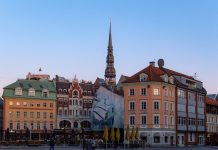![]() Copyright: Sophia Sorge
Copyright: Sophia Sorge
I get the S-Bahn and what do I see? At first nothing. The last stop, Teltow-Stadt, lies in a valley. Teltow only unfurls in front of me after I’ve made my way up a several steps: a row of green and orange concrete housing blocks. My companion and I make our way to the old town. In doing so, we pass the town’s church of St. Andreas, a renovated and beautiful building. Light from the chandeliers streams through the colourful church windows. According to Wikipedia this is the town’s main attraction, which has been lovingly nicknamed Rübchenstadt – meaning ‘little parsnip town’ – by its residents. The Teltow parsnip has been grown in surrounding land for the past 300 years, a noble vegetable from Brandenburg border.
A hundred meters on there is the market square with a new town hall and a memorial commemorating the former District administrator von Stubenrauch, creator of the Teltow canal. The surrounding houses are beautiful and spread somewhat of vintage charm. That’s about all that meets the eye at first.
We stand around awkwardly when a car pulls up next to us. A friendly couple points us in the direction of the ‘Marina’, a harbour project by the Teltow canal. It was probably my camera that gave us away as tourists. As it turns out, the harbour is nowhere near completion. All we can see is an enclosed churned up field down by the river. My imagination has to suffice: I’m sure in a few years’ time it’ll be possible to stroll along a wonderfully modern harbour by the river bank.
I have to admit I wasn’t fully convinced walking through this place but maybe it’s just the wrong day – grey sky, bare trees and not a single person on the streets. A day trip in April would’ve made more sense, when the town was still celebrating its 750th jubilee, or maybe a later trip would be more promising. You’re sure to bump into one of the towns 25,000 residents at, for example, the Rübchenfest, the annual celebration of the parsnip.
Translation: Louise Brenner










